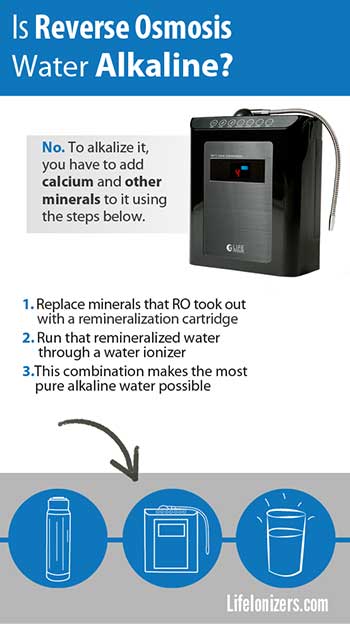Is reverse osmosis water alkaline? No. Reverse osmosis water is nearly pure water with a PH of 7. Reverse osmosis is a filtration method that removes more than 99% of all the contaminants in water.

The result is nearly pure water, which which has neutral pH of 7. But if it’s exposed to air, RO water drops down to an acidic pH range of 5 – 5.5. Why? Pure water is very hungry. it actually grabs CO2 right out of the air! Within about an hour, a glass of pure RO water can drop from a pH of 7 down to a pH of 5.5 or lower and become acidic water. Alkaline water has a pH of greater than 7, so reverse osmosis water is not alkaline water. To alkalize it, you have to add calcium and other minerals to it.
Why air makes reverse osmosis water acidic
Increasing levels of carbon in the air are causing oceans, lakes, rivers, and streams to become more acidic. When water absorbs CO2 from the air, it makes a solution of carbonic acid. Here’s the chemical reaction: H20 + CO2 = H2CO3. The purer the source of water is, the more CO2 it can absorb, and the more acidic it will get. Reverse osmosis and distillation both produce nearly pure water, so both forms of water will readily turn acidic when exposed to air.
What makes alkaline water alkaline
To raise the pH of reverse osmosis water and make it alkaline you have to add something to it. Water in nature is never pure, it always has stuff in it, mostly mineral salts. Those substances are what causes the pH of the water to be higher or lower than 7. Tap water gets its pH mostly from calcium bicarbonate and magnesium bicarbonate. These mineral salts are what causes the hard water deposits that clog your appliances. They also usually raise the pH of water, which is why nearly all tap water is slightly alkaline. Water that is acidic usually has a low mineral salt content.
How a water ionizer works
A water ionizer raises the pH of tap water when it ionizes it into alkaline water. That happens because water ionizers change the mineral salts in tap water. Ionizers change the bicarbonate mineral salts in tap water into mineral hydroxide salts. Mineral hydroxide salts are a lot more alkaline than mineral carbonate salts. Changing the bicarbonate salts into hydroxide salts also makes the water into an antioxidant. The hydroxide part of the mineral hydroxides in water puts hydroxyl ions in the water. The hydroxyl ion is a powerful antioxidant. Compare RO water to tap water and to alkaline water in the table below:
| Reverse Osmosis water | Tap water | Alkaline water |
| Nearly pure H2O
Starts at a pH of 7 pH drops when exposed to air Not an antioxidant |
Contains bicarbonate salts
pH of 7 or slightly higher Not an antioxidant |
Contains hydroxide salts
pH is higher than 7 Contains antioxidant hydroxyl ions |
The hydroxyl ions in alkaline water are what makes it better for your health than plain water. They act as antioxidants, helping to protect tissues and DNA from oxidative damage. The minerals in the water contribute alkalinity, which helps the body neutralize acids. Alkaline water is also easier to absorb than plain water, so it hydrates better
How to make reverse osmosis water alkaline
There are two steps for turning RO water into alkaline water.
First, The minerals that reverse osmosis took out must be replaced. Minerals are returned to RO water using a remineralization cartridge. These cartridges add calcium, magnesium, and other trace minerals that are essential for good health. The remineralizing cartridge is added to the output of the RO system.
Second, the re-mineralized water is then run through a water ionizer. The ionizer changes the bicarbonate salts in the water supplied by the remineralizing cartridge into hydroxide salts.
Medical grade alkaline water: Using the combination of reverse osmosis, remineralization, and water ionization make the purest alkaline water possible. This is the process that is used in health clinics and doctors offices to make antioxidant alkaline water to exacting medical specifications.
Can you remineralize your RO water into alkaline water?
There is no remineralizing cartridge that supplies mineral hydroxides. The reason for that is that mineral hydroxides are very reactive to air. When exposed to air, mineral hydroxides rapidly convert to mineral bicarbonates because they absorb CO2 from the air. For the same reason, when you make alkaline water, you have to store it in a sealed container. The CO2 and the oxygen in the air react with the mineral hydroxides in the alkaline water. The oxygen in air oxidizes them, and the CO2 acidifies them, so the healthy properties of the alkaline water are quickly lost.
Life Ionizers can set up medical grade alkaline water systems
If you want the purest alkaline water possible, there’s no better way than reverse osmosis with remineralization and a Life Ionizer. We have everything you need, just call.
1 comment
Anna Brown
Can you tell me what minerals are added to make the water alkaline? Just curious if you use calcium carbonate so I was wondering.